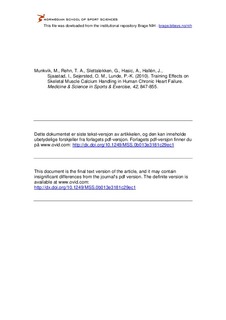| dc.contributor.author | Munkvik, Morten | |
| dc.contributor.author | Rehn, Tommy A. | |
| dc.contributor.author | Slettaløkken, Gunnar | |
| dc.contributor.author | Hasic, Almira | |
| dc.contributor.author | Hallén, Jostein | |
| dc.contributor.author | Sjaastad, Ivar | |
| dc.contributor.author | Sejersted, Ole M. | |
| dc.contributor.author | Lunde, Per Kristian | |
| dc.date.accessioned | 2011-05-02T11:47:25Z | |
| dc.date.available | 2011-05-02T11:47:25Z | |
| dc.date.issued | 2010-05 | |
| dc.identifier | Seksjon for fysisk prestasjonsevne / Department of Physical Performance | |
| dc.identifier.citation | Medicine & Science in Sports & Exercise. 2010, 42(5), 847-855 | en_US |
| dc.identifier.issn | 0195-9131 | |
| dc.identifier.uri | http://hdl.handle.net/11250/170809 | |
| dc.description | I Brage finner du siste tekst-versjon av artikkelen, og den kan inneholde ubetydelige forskjeller fra forlagets pdf-versjon. Forlagets pdf-versjon finner du på www.ovid.com: http://dx.doi.org/10.1249/MSS.0b013e3181c29ec1 / In Brage you'll find the final text version of the article, and it may contain insignificant differences from the journal's pdf version. The definitive version is available at www.ovid.com: http://dx.doi.org/10.1249/MSS.0b013e3181c29ec1 | en_US |
| dc.description.abstract | Purpose: Patients with chronic heart failure (CHF) typically complain about skeletal muscle fatigue. In rat experiments, reduced intracellular calcium release seems to be related to fatigue development in normal skeletal muscle but not in muscle from rats with CHF. We therefore hypothesize that training may not improve intracellular calcium cycling to the same extent in muscles from patients with CHF compared with healthy controls (HC).
Methods: Thirteen HC and 11 CHF patients performed 6 wk of unilateral knee extensor endurance training. Computed tomographic examinations of the thigh and biopsies of vastus lateralis were obtained bilaterally before and after the training period.
Results: Peak power of the trained leg was 10% and 14% greater than that in the untrained leg in HC and CHF, respectively. For the HC, training resulted in a higher Ca2+ release rate and a lower leak in the trained leg associated with a tendency of increased ryanodine receptor (RyR) content with reduced phosphorylation level. In the trained leg of CHF patients, RyR content was reduced without associated changes of either Ca2+ leak or release rate.
Conclusions: Training in HC has an effect on Ca2+ leak and release of the sarcoplasmic reticulum, but in CHF patients, training is achieved without such changes. Thus, calcium handling seems not to be the site of decreased exercise tolerance in CHF. | en_US |
| dc.language.iso | eng | en_US |
| dc.publisher | Wolters Kluwer | en_US |
| dc.subject | sarcoplasmic reticulum | en_US |
| dc.subject | knee extensor | en_US |
| dc.subject | male | en_US |
| dc.subject | citrate synthase | en_US |
| dc.subject | computed tomography | en_US |
| dc.subject | mhc isoform | en_US |
| dc.title | Training effects on skeletal muscle calcium handling in human chronic heart failure | en_US |
| dc.type | Journal article | en_US |
| dc.type | Peer reviewed | en_US |
| dc.subject.nsi | VDP::Social science: 200::Social science in sports: 330::Other subjects within physical education: 339 | en_US |
| dc.source.pagenumber | 847-855 | en_US |
